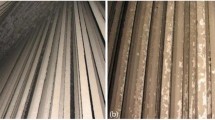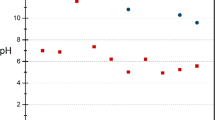Abstract
Metal corrosion and ash deposition are two common issues in municipal solid waste incineration (MSWI) plants. An in-situ sampling investigation was conducted in an MSWI plant in Jiangsu, China. The deposit samples were collected from 6 convective heating surfaces including the reheaters, superheaters, and economizer. The corrosion samples were obtained from a ruptured tube cut from the tertiary superheater. The element composition, crystal phases, and morphology of deposit and corrosion samples were characterized and analyzed. The results show that S contents of these deposits are 32–45 wt%, considerable Cl (10.63 wt%) was only detected in the deposits of the tertiary superheater. The composition of the deposits varies with the location because the flue gas temperature determines the thermodynamic trend of the sulfation reactions of different chlorides and the SO2 equilibrium partial pressure required in these reactions. Ca sulfates mainly exist in deposits at high temperatures (above approximately 500 °C). Whereas alkali metal sulfates are the main component of deposits at low temperatures (below approximately 500 °C). A multi-layer structure is exhibited on the cross-section of the corrosion samples. The discovery of Cl in the interface between the matrix and the oxide layer confirms that Cl can penetrate the outer oxide film. Besides, polysulfate components were observed inside the metal oxide layers, which indicates that a melt has occurred there. This study has provided a better understanding of ash deposition and corrosion phenomena in MSWI systems and more emphasis should be placed on the research of ash deposition and corrosion mechanisms.










Similar content being viewed by others
References
Tabata, T. 2013. Waste-to-energy incineration plants as greenhouse gas reducers: a case study of seven Japanese metropolises. Waste Management & Research: The Journal for a Sustainable Circular Economy. 31: 1110–1117.
Wienchol, P., Szlęk, A., and Ditaranto, M. 2020. Waste-to-energy technology integrated with carbon capture—Challenges and opportunities. Energy 198: 117352.
Grabke, H.J., Reese, E., and Spiegel, M. 1995. The effects of chlorides, hydrogen chloride, and sulfur dioxide in the oxidation of steels below deposits. Corrosion Science 37: 1023–1043.
Qu, Z., Zhong, R., and Wang, L. 2020. High temperature corrosion protection of heating surface metals of waste incineration power generation boilers: a review. Journal of Physics. Conference series: IOP Publishing 1649: 012031.
Zhang, Y., Du, X., Yue, M., et al. 2020. Heat transfer and ash deposition performance of heat exchange surface in waste incineration flue gas. International Journal of Heat Mass Transfer 155: 119691.
Lee, Y.Y., and McNallan, M.J. 1987. Ignition of nickel in environments containing oxygen and chlorine. Metallurgical and Materials Transactions A 18: 1099–1107.
Reichelt, J., Pfrang-Stotz, G., Bergfeldt, B., et al. 2013. Formation of deposits on the surfaces of superheaters and economisers of MSW incinerator plants. Waste Management 33: 43–51.
Hansen, L.A., Nielsen, H.P., Frandsen, F.J., et al. 2000. Influence of deposit formation on corrosion at a straw-fired boiler. Fuel Processing Technology 64: 189–209.
Ma, W., Wenga, T., Zhang, N., et al. 2017. Full-scale experimental investigation of deposition and corrosion of pre-protector and 3rd superheater in a waste incineration plant. Scientific Reports 7: 17549.
Ma, W., Wenga, T., Frandsen, F.J., et al. 2020. The fate of chlorine during MSW incineration: vaporization, transformation, deposition, corrosion and remedies. Progress in Energy and Combustion Science 76: 100789.
Karlsson, S., Pettersson, J., Svensson, J.E., et al. 2011. KCl-induced high temperature corrosion of the austenitic stainless steel 304L-the Influence of SO2. Materials Science Forum 696: 224–229.
Enestam, S., Bankiewicz, D., Tuiremo, J., et al. 2013. Are NaCl and KCl equally corrosive on superheater materials of steam boilers? Fuel 104: 294–306.
Karlsson, S., Pettersson, J., Johansson, L.G., et al. 2012. Alkali induced high temperature corrosion of stainless steel: The influence of NaCl, KCl and CaCl2. Oxidation of Metals 78 (1–2): 83–102.
Pettersson, J., Folkeson, N., Johansson, L., et al. 2011. The effects of KCl, K2SO4 and K2CO3 on the high temperature corrosion of a 304-type austenitic stainless steel. Oxidation of Metals 76 (1–2): 93–109.
Lu, W.M., Pan, T.J., Zhang, K., et al. 2008. Accelerated corrosion of five commercial steels under a ZnCl2–KCl deposit in a reducing environment typical of waste gasification at 673–773K. Corrosion Science 50 (7): 1900–1906.
Li, Y.S., Spiegel, M., and Shimada, S. 2005. Corrosion behaviour of various model alloys with NaCl–KCl coating. Materials Chemistry and Physics 93 (1): 217–223.
Skrifvars, B.J., Backman, R., Hupa, M., et al. 2008. Corrosion of superheater steel materials under alkali salt deposits Part 1: The effect of salt deposit composition and temperature. Corrosion Science 50 (5): 1274–1282.
Wang, L., Øye, B., Skreiberg, Ø., et al. 2017. Characterization of ash deposits from municipal solid waste (MSW) incineration plants. Energy Procedia 142: 630–635.
Chen, G., Zhang, N., Ma, W., et al. 2015. Investigation of chloride deposit formation in a 24MWe waste to energy plant. Fuel 140: 317–327.
Lai, Z., Ma, X., Tang, Y., et al. 2014. Deposit analysis of water-wall tubes in a municipal solid waste grate incinerator. Applied Thermal Engineering 66: 415–422.
Otsuka, N. 2008. A thermodynamic approach on vapor-condensation of corrosive salts from flue gas on boiler tubes in waste incinerators. Corrosion Science 50: 1627–1636.
Verbinnen, B., De Greef, J., and Van Caneghem, J. 2018. Theory and practice of corrosion related to ashes and deposits in a WtE boiler. Waste Management 73: 307–312.
Iribarne, J.V., Anthony, E.J., and Iribarne, A. 2003. A scanning electron microscope study on agglomeration in petroleum coke-fired FBC boilers. Fuel Processing Technology 82: 27–50.
Pettersson, A., Niklasson, F., and Moradian, F. 2013. Reduced bed temperature in a commercial waste to energy boiler—Impact on ash and deposit formation. Fuel Processing Technology 105: 28–36.
Zhao, J., Li, B., Wei, X., et al. 2020. Slagging characteristics caused by alkali and alkaline earth metals during municipal solid waste and sewage sludge co-incineration. Energy 202: 117773.
Spiegel, M. 1999. Salt melt induced corrosion of metallic materials in waste incineration plants. Materials and Corrosion 50: 373–393.
Funding
National Basic Research Program of China (973 Program), Grant No. 2018YFC1901302, Qunxing Huang, Innovative Research Group Project of the National Natural Science Foundation of China, Grant No. 51621005, Xuguang Jiang.
Author information
Authors and Affiliations
Corresponding author
Ethics declarations
Conflict of interest
The authors declare that they have no known competing financial interests or personal relationships that could have appeared to influence the work reported in this paper.
Additional information
Publisher's Note
Springer Nature remains neutral with regard to jurisdictional claims in published maps and institutional affiliations.
Supplementary Information
Below is the link to the electronic supplementary material.
Rights and permissions
About this article
Cite this article
Liu, X., Chen, Q., Long, L. et al. In-situ sampling investigation of deposition and corrosion of convective heating surfaces in a grate type municipal solid waste incineration plant: a case study. Waste Dispos. Sustain. Energy 3, 299–308 (2021). https://doi.org/10.1007/s42768-021-00087-8
Received:
Revised:
Accepted:
Published:
Issue Date:
DOI: https://doi.org/10.1007/s42768-021-00087-8




